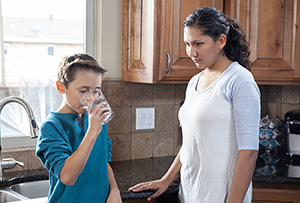Dehydration and Rehydration in Children
Dehydration happens when a person loses more fluids than they take in. The human body is made up largely of water, so you need the right balance of fluids in your system for good health. Large amounts of fluids can be lost through fever, diarrhea, vomiting, or sweating. Dehydration happens very quickly in babies and small children. This is because they don’t have as much fluid to spare. Dehydration can quickly become very serious. Rehydration is the important way of returning those fluids back to the body. This restores normal functioning.

Signs of dehydration
Watch for these signs of dehydration. This is especially true if your child has a fever or diarrhea, or is vomiting:
-
Dry mouth or extreme thirst
-
Fewer than 6 wet diapers a day for babies, or less frequent urination in older children
-
Fussy or agitated behavior
-
Looking or acting very tired or weak, or increased sleeping
Treating dehydration
If you suspect dehydration, call your healthcare provider. You can treat mild dehydration at home by doing the following:
-
Keep track of how much fluid your child drinks and how often they urinate.
-
Breastfeed or bottle-feed a sick baby more often, but for shorter periods of time.
-
For vomiting or diarrhea, give your child 1 to 2 teaspoons of an oral rehydration solution -every 10 minutes. Continue until your child can drink larger amounts of fluid without vomiting or passing stool.
-
Stay away from soft drinks, tea, juice, broth, or sports drinks, such as electrolyte solutions. These may make symptoms worse.
-
Don't use medicines for vomiting and diarrhea, unless your healthcare provider tells you to.
-
If your child has a hard time keeping fluids down and becomes very dehydrated, your healthcare provider may decide to treat them in a hospital. There, a healthcare provider can make your child comfortable. Your child will be given fluids and nourishment by mouth or through an IV (intravenous) line. Medicine may be given to stop the vomiting and allow your child to drink enough fluid to stay hydrated.
When to get medical care
Get medical care right away if your child:
-
Has fever (see Fever and children, below)
-
Is a baby vomiting all feeds (not just spitting up)
-
Hasn’t urinated for 6 hours or more, or has dark or strong-smelling urine
-
Can’t drink even small amounts of liquid without vomiting
-
Can't be soothed or is very irritable or restless
-
Seems unusually drowsy, listless, weak, or limp
-
Has muscle cramps
-
Has dry, wrinkled, or pasty-looking skin, sunken-looking eyes, a very dry or sticky mouth, or cracked lips
Fever and children
Use a digital thermometer to check your child’s temperature. Don’t use a mercury thermometer. There are different kinds and uses of digital thermometers. They include:
-
Rectal. For children younger than 3 years, a rectal temperature is the most accurate.
-
Forehead (temporal). This works for children age 3 months and older. If a child under 3 months old has signs of illness, this can be used for a first pass. The provider may want to confirm with a rectal temperature.
-
Ear (tympanic). Ear temperatures are accurate after 6 months of age, but not before.
-
Armpit (axillary). This is the least reliable but may be used for a first pass to check a child of any age with signs of illness. The provider may want to confirm with a rectal temperature.
-
Mouth (oral). Don’t use a thermometer in your child’s mouth until they are at least 4 years old.
Use the rectal thermometer with care. Follow the product maker’s directions for correct use. Insert it gently. Label it and make sure it’s not used in the mouth. It may pass on germs from the stool. If you don’t feel OK using a rectal thermometer, ask the healthcare provider what type to use instead. When you talk with any healthcare provider about your child’s fever, tell them which type you used.
Below are guidelines to know if your young child has a fever. Your child’s healthcare provider may give you different numbers for your child. Follow your provider’s specific instructions.
Fever readings for a baby under 3 months old:
-
First, ask your child’s healthcare provider how you should take the temperature.
-
Rectal or forehead: 100.4°F (38°C) or higher
-
Armpit: 99°F (37.2°C) or higher
Fever readings for a child age 3 months to 36 months (3 years):
-
Rectal, forehead, or ear: 102°F (38.9°C) or higher
-
Armpit: 101°F (38.3°C) or higher
Call the healthcare provider in these cases:
-
Repeated temperature of 104°F (40°C) or higher in a child of any age
-
Fever of 100.4° (38°C) or higher in baby younger than 3 months
-
Fever that lasts more than 24 hours in a child under age 2
-
Fever that lasts for 3 days in a child age 2 or older